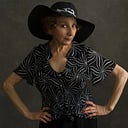Post Stroke Mumblings — Part 13
You Discover What You Can’t do …
It was the first week in July, I had been out of the hospital for roughly three weeks and was itching to get stuff done in the garden. The beautiful Iris in the lead image was beckoning to me in the front garden.
I had already been making little forays outside, but I had been strongly cautioned by my home-visiting physio ladies, Anna and Grażyna, to be very careful not to overdo anything. Daily rehab exercises, yes. A small amount of supervised cooking and kitchen work, yes. A small amount of supervised gardening, yes, but always with the walker and the garden seat handy. And most importantly — no activity for too long.
Slowly and cautiously, I got out in the garden a little while every day, using the walker to get into the area I wanted to work in. Then, I got someone to bring my garden stool to the location I was targeting so that I could sit. I was able to get a limited amount of weeding and pruning done.
It was shocking to me how many ordinary things I was unable to do easily. A simple task like opening the fridge door and getting a carton of eggs out and onto the counter was now a multi-part operation.
Getting eggs out for breakfast
- manouver over to fridge using walker
- open fridge door while holding onto walker with one hand
- reach in and get hold of egg carton with one hand while holding onto walker with other hand
- bring carton out of fridge and slide onto counter beside fridge.
- close fridge door, while holding onto walker
- move sideways towards counter holding walker and get positioned in front of counter beside fridge
- slide carton along counter toward sink with one hand, while holding walker with the other, and sliding sideways
- Stop at sink in front of counter
- slide egg carton along the front edge of counter to the stove while edging walker in the same direction.
- line up egg carton beside previously obtained bowl, holding counter with the other hand
- Open egg carton and remove an egg with one hand, holding counter with the other hand
- break into bowl one handed, holding counter with the other hand
- curse when bits of shell break off into bowl.
- walk-slide sideways along counter to get a spoon to remove broken egg shell.
- Repeat step 11 until required number of eggs are beside bowl.
- Repeat step 12 until required eggs are broken into bowl.
So, this is a small sample of how really simple, everyday tasks were complicated by not having full control of my body. Kitchen layout below.
Getting dressed
For us girls the act of putting on and doing up a bra is a very basic dressing task. Pretty easy, you think. However, when your left hand and arm do not really want to cooperate with you, and you’re trying to reach behind you to either hook or unhook your bra, “easy ‘ goes out the window.
My initial solution was to just wear pull-on ones with no hooks. However, those give you no shape or support whatsoever.
Finally, I concluded that I could put the regular darn things on by swinging them around and doing the hooks up in front of me and then twirling the thing around and getting my arms through the loops of the straps, a relatively easy task but really annoying.
Note: before any of you smarties ask why not just get a front hooking bra, I was in no position to go shopping at this stage, nor in the mood to look online.
Putting on and taking off pants
This is a task that applies to both men and women. As we get older, it often gets harder to perform it while standing, but after a stroke, “harder” becomes “impossible”.
At the hospital, as soon as they let me lose the hospital gown, I had taken to wearing ordinary jogging pants. With an elasticized waist, loose fitting comfortable knit fabric, these pants were a fairly easy option for me.
Once I was home, I realized that joggers would be around for a while. Gone were my denim jeans. Way too hard to get on and off, and if I could have gotten them on, trying to pull up the zipper, and do up the top button? Not a chance.
It was way easier to get those joggers on and off, and they were comfortable and cosy. But, it was super annoying not to be able to wear jeans.
Putting on a pair of shoes
Another supposedly easy task, putting on your shoes. Not so easy to pull laces through and do them up because you need both hands to be functioning properly and in my case the left hand had other ideas. Plus you needed to be sitting down and bending over, not safe for me since I tended to fall over easily. Therefore, slip on shoes were the only practical option.
It wasn’t just the left hand that caused shoe trouble. My left foot and leg were really swollen, which made getting a shoe on the left foot especially challenging. So we start with the uncooperative left hand, swollen and uncooperative left foot, and now the task of forcing that foot into a shoe is really hard. I was able to get some help using a super long (3-foot long) shoe horn (thank you, Ikea)
Furthermore, you couldn’t just put on regular shoes, you needed to have shoes with fairly light soles, but sturdy. If the soles were too heavy they would encumber you walking.
(Here, I will give a big shoutout to Sketchers. When you need a relatively nice looking, slip-on, lightweight shoe with decent grip in the soles, and not costing an arm and a leg, Sketchers are excellent.)
Once I had managed to fight the shoes on, my next issue was actually getting up and walking.
I had to make sure that the walker was close by so that I could haul myself out of the chair.
Walking around
Most of us take for granted that we are going to be able to stand and walk around, post stroke these things are tricky.
Walking around required use of the walker.
This device is helpful because you are able to use it for balance and to assist you in moving forward fairly smoothly. Mine has two wheels on the front and legs at the back. You can quickly set the legs down if feeling tippy and stop the wheels from rolling.
Walking is not fast with this device, but one feels fairly secure. I learned to manouver it around the house, up and down the front entrance steps, and up to the kitchen sink with few mishaps. Also used it to get around in the garden. However it did bring home the fact that I now needed four legs instead of two to get around.
Being on the ground and getting up from the ground
Another thing that one tends not to think of until one is unable to do it. This was another multi-step procedure, and it greatly relied on being close enough to something like a chair or a couch that one could use to haul oneself upon.
Ana and Grażyna said it was beneficial to practice in the event of falling. They suggested that you would crawl to the closest solid item, such as a couch, which is very solid, and pull yourself up onto that.
I experimented with that process and determined that the best plan was not to be on the ground, if at all possible. My upper body strength was greatly reduced at this point, so dragging myself up onto the couch (or anything else) was possible but very exhausting.
I actually did manage to do a couple of faceplants in the garden, but I was able to get up once using the garden bench to pull myself up. and the other time by grabbing onto the small but sturdy trunk of the paperbark maple to get myself upright. Fortunately, nobody saw those two little mishaps.
The reality is that after a stroke, things do not return to normal in a hurry.
More on that in the next episode.

